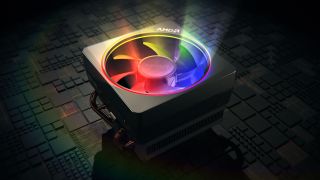AMD introduces two APUs for DIY builders capable of 1080p gaming
Gaming without a graphics card is about to get a double hit of goodness, albeit at a high price.

It's been a long time coming, but we're finally going to get a pair of Zen 3-powered APUs from AMD that'll be capable of gaming. The Ryzen 7 5700G and Ryzen 5 5600G will be available August 5 and cost $359 and $259 respectively.
They'll slot it into existing 400 and 500 series motherboards and offer some pretty decent performance numbers by the look of things. And in case you're wondering, yes, they come with coolers and are overclockable too.
While its previous generation of APUs, headed by the Ryzen 5 3400G, mainly focused on 720p gaming for smooth framerates, this new generation is gunning for 1080p performance. AMD highlighted this to us in a briefing prior to the Computex announcement by saying Hi-Rez Sutdios' Rogue Company managed an average of 78fps at 1080P using the high settings.
Not bad for integrated graphics.
It also couldn't help but throw some shade at Intel's offerings, with a few comparisons to the Core i7 11700 that showed the Ryzen 7 5700G offering twice the performance in the likes of Warframe and Fortnite.
In case you're wondering, that Intel chip uses intel's UHD Graphics 750 silicon, not its more-recently developed Xe cores—which you can't actually get on the desktop yet. Likewise, these new APUs don't use AMD's more recent RDNA 2 architecture either, or even RDNA 1, they're still resolutely Vega parts.
| Header Cell - Column 0 | Ryzen 7 5700G | Ryzen 5 5600G |
|---|---|---|
| Cores / Threads | 8 / 16 | 6 / 12 |
| Base Clock | 3.8 GHz | 3.9GHz |
| Max Boost Clock | 4.6GHz | 4.4GHz |
| Total L2 Cache | 4MB | 3MB |
| Total L3 Cache | 16MB | 16MB |
| Graphics Core Count | 8 CUs | 7 CUs |
| Graphics frequency | 2.0GHz | 1.9GHz |
| PCI Express Version | 3.0 | 3.0 |
| TDP | 65W | 65W |

Best CPU for gaming: the top chips from Intel and AMD
Best graphics card: your perfect pixel-pusher awaits
Best SSD for gaming: get into the game ahead of the rest
The full specs of the chips make for pretty good reading all the same, though, and are competitive with what AMD currently has out there, with one important exception—like their mobile stablemates, these two APUS are limited to supporting PCIe 3.0 and not the newer PCIe 4.0. The latest next-gen NVMe SSDs will still work, but they won't hit their full potential with these chips and will be limited to 3,500MB/s.
The biggest gaming news, reviews and hardware deals
Keep up to date with the most important stories and the best deals, as picked by the PC Gamer team.
Still, this one annoyance aside, these look like good options for anyone looking to build a gaming machine on a budget. The 5700G having 8 compute units capable of running at 2.0GHz would be the preference here of course, although 7 CUs at 1.9GHz for $100 less may be the way to go. We'll have to see when we get them in our test rigs.
AMD actually announced these chips back in April, but at the time they were only available to OEMs. There was a third chip back then, the Ryzen 5 5300G—a 4-core, 8-thread APU with 6 CUs—but that appears to have been cut. That's a shame, as that would have been the more affordable option.
August 5 suddenly feels like a long way off.
Alan has been writing about PC tech since before 3D graphics cards existed, and still vividly recalls having to fight with MS-DOS just to get games to load. He fondly remembers the killer combo of a Matrox Millenium and 3dfx Voodoo, and seeing Lara Croft in 3D for the first time. He's very glad hardware has advanced as much as it has though, and is particularly happy when putting the latest M.2 NVMe SSDs, AMD processors, and laptops through their paces. He has a long-lasting Magic: The Gathering obsession but limits this to MTG Arena these days.
Most Popular






